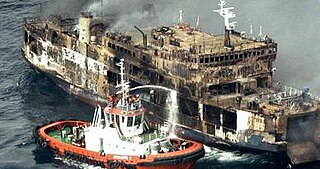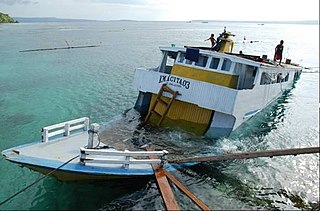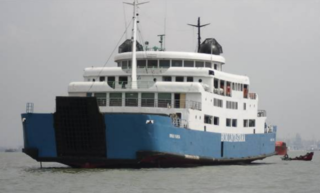
The MS al-Salam Boccaccio 98 was an Egyptian Ro/Ro passenger ferry, operated by El Salam Maritime Transport, that sank on 3 February 2006 in the Red Sea en route from Duba, Saudi Arabia, to Safaga in southern Egypt.

The Levina 1 was an Indonesian passenger ferry. On 22 February 2007, it caught fire, killing at least 51 people. Three days later, on 25 February, it sank with a group of journalists and investigators on board, killing at least one more and leaving three missing.

The Salem Express was a passenger ship that sank in the Red Sea. It is notable due to the heavy loss of life which occurred when she sank shortly after striking a reef at around 11:13pm on Saturday December 14, 1991.

The sinking of MV Teratai Prima occurred on January 11, 2009, around 04:00 local time when a ferry carrying more than 300 people capsized in the Makassar Strait off West Sulawesi, Survivors stated that the ferry had been slammed by 4-metre (13 ft) waves twice. The first one hit so hard that the ship became unbalanced, before another wave hit from a different direction and sank the vessel.

KMP Tampomas II was a roll on-roll off car and passenger ferry owned by the Indonesian shipping company Pelni that burned and sank in the Java Sea while sailing from Jakarta to Ujung Pandang, South Sulawesi on 27 January 1981. This disaster resulted in the deaths of hundreds of passengers.
2016 (MMXVI) was a leap year starting on Friday of the Gregorian calendar, the 2016th year of the Common Era (CE) and Anno Domini (AD) designations, the 16th year of the 3rd millennium and the 21st century, and the 7th year of the 2010s decade.

On 3 December 2016, a PZL M28 Skytruck of the Indonesian National Police disappeared above the South China sea while approaching Hang Nadim Airport in Riau Islands. The aircraft was conducting a flight from Depati Amir Airport in Pangkal Pinang, the capital of Bangka Belitung province. The aircraft was carrying three pilots and ten passengers with no survivors on the aircraft. A search and rescue team was assembled by the Indonesian National Search and Rescue Agency with assistance from Singapore.
MV Sinar Bangun sank on 18 June 2018 in Lake Toba, North Sumatra, Indonesia, during its trip from Simanindo Harbour in Samosir Island to Tiga Ras Harbour in Simalungun Regency. The ferry was carrying 188 passengers and crew. After the sinking, authorities immediately deployed search and rescue personnel to the area. Twenty-one survivors were rescued, three bodies were found and 164 people were listed as missing and presumed dead.

The sinking of MV Marina Baru 2B occurred just after noon on 19 December 2015. The high speed vessel carrying 112 passengers and crew sank off the coast of Bone, South Sulawesi in inclement weather conditions. A nine-day search and rescue operation, conducted by authorities, successfully rescued 45 survivors and recovered 65 bodies from the sea. Twelve people were declared missing and presumed dead.

MV Lestari Maju was a modified 749 tonnes cargo ship that operated domestic passenger service from Bulukumba Regency to Selayar Islands in South Sulawesi. At noon on 3 July 2018, the ship was deliberately grounded off the Selayar Islands. The ferry had reportedly suffered a leak on the port side of the lower deck. As the ferry began to sink, the captain decided to ground the ferry to stop the sinking and ease the rescue effort. The incident killed 35 people; 155 people survived the accident.

Lion Air Flight 610 was a scheduled domestic passenger flight from Soekarno–Hatta International Airport, Jakarta to Depati Amir Airport, Pangkal Pinang in Indonesia. On 29 October 2018, the Boeing 737 MAX operating the route crashed into the Java Sea 13 minutes after takeoff, killing all 189 passengers and crew. It was the first major accident involving the new Boeing 737 MAX series of aircraft, introduced in 2017, and the highest death toll of any accident or incident involving the entire Boeing 737 series, Original, Classic, Next Generation or MAX, surpassing Air India Express Flight 812 in 2010. It was the deadliest accident in Lion Air's history, surpassing the 2004 Lion Air Flight 538 that killed 25, and the second deadliest aircraft accident in Indonesia behind Garuda Indonesia Flight 152.

The sinking of MV Wahai Star occurred on the night of 10 July 2007, when a speedboat tugged by the ferry accidentally crashed into its stern, resulting in a major leak. In the following days, rescuers managed to save 43 people, while 16 bodies were recovered in the nearby waters.

The sinking of MV Acita 03 occurred on the night of 18 October 2007 when a ferry carrying 174 passengers and crews accidentally capsized during its docking in Baubau, Southeast Sulawesi. 134 passengers and crews survived the disaster while 30 passengers and 1 crew member lost their lives. 9 people were listed as missing and presumed dead.
MV Lintas Timur was an Indonesian cargo ship which sank off the eastern coast of Sulawesi on 1 June 2019. The sinking of the vessel caused all but one of the ship's eighteen crew to be lost at sea.

The Zahro Express disaster occurred on the morning of 1 January 2017 when an Indonesian-flagged wooden passenger vessel caught fire in the waters of Thousands Islands Regency, off the coast of Jakarta. She was travelling from Jakarta's Muara Angke to Tidung Island, a popular tourist destination. The ferry, named MV Zahro Express, was carrying 216 passengers and 5 crew members. Of the 221 passengers and crews, a total of 24 people on board lost their lives.

MV Laut Teduh II was an Indonesian-flagged double-ended RO/RO passenger ferry that served the route from Port of Merak in Java and Port of Bakauheni in Sumatra, one of the busiest ferry route in Indonesia. She was built in 1988 in England and was registered as Laut Teduh II in 2007.

KRI Tanjung Nusanive (973) was a troop ship of the Indonesian Navy. The ship was built at Meyer Werft, Papenburg and completed in 1984 as passenger ferry KM Kambuna of the state-owned Pelni shipping company. KM Kambuna served with Pelni until 2005 when she was transferred to the Indonesian Navy, which operated the ship until its decommissioning in early 2020.

The MS Estonia sank on Wednesday, 28 September 1994, between about 00:50 and 01:50 (UTC+2) as the ship was crossing the Baltic Sea, en route from Tallinn, Estonia, to Stockholm, Sweden. The sinking was one of the worst maritime disasters of the 20th century. It is one of the deadliest peacetime sinkings of a European ship, after the RMS Titanic in 1912 and the RMS Empress of Ireland in 1914, and the deadliest peacetime shipwreck to have occurred in European waters, with 852 lives lost.

KRI Tanjung Kambani (971) is a troopship of the Indonesian Navy. She was built in 1982 as ro-ro ferry and previously named Kobe Maru, Car Ferry Cheju No.2 and Dong Yang Express Ferry No.6.

MV. Windu Karsa was an Indonesian-flagged double-ended RO/RO ferry that served the route from Luwu, South Sulawesi to Kolaka, Southeast Sulawesi. Built in Fujiwara Shipyard in 1980, she has served in Indonesia for more than 20 years.

















